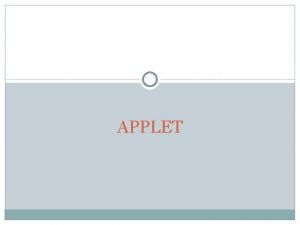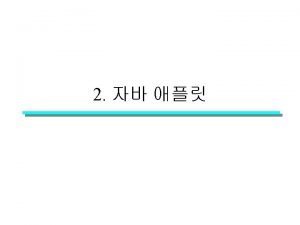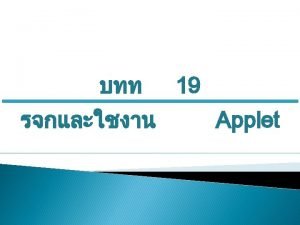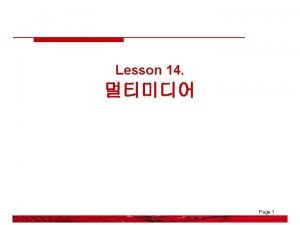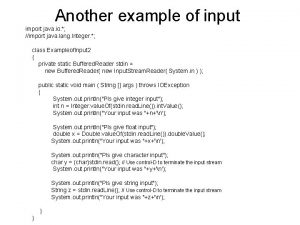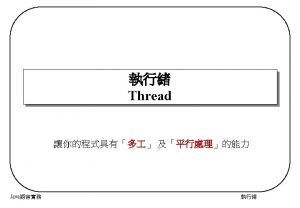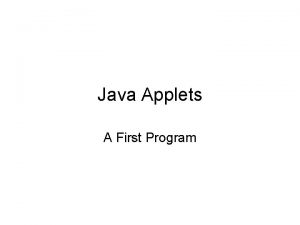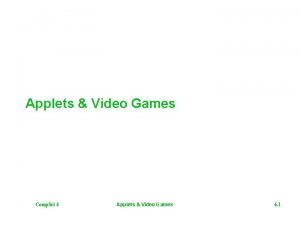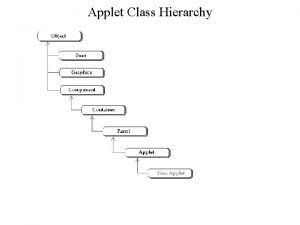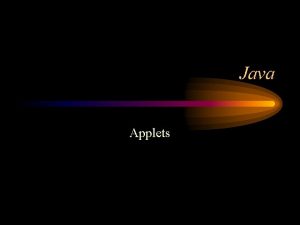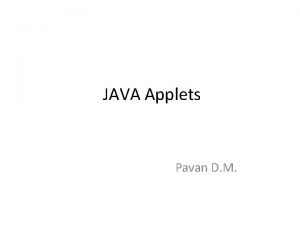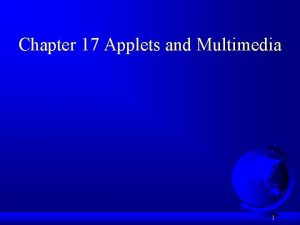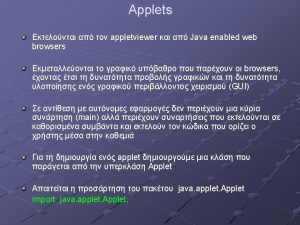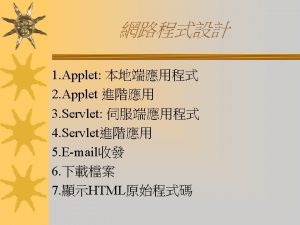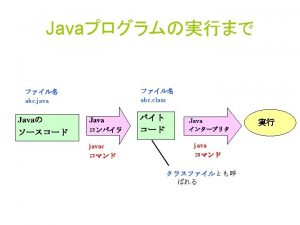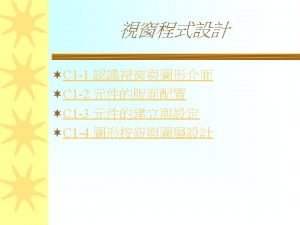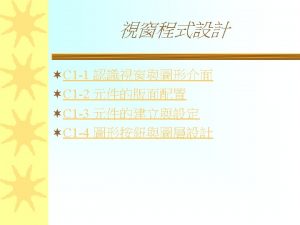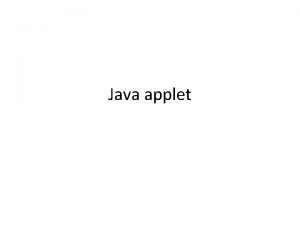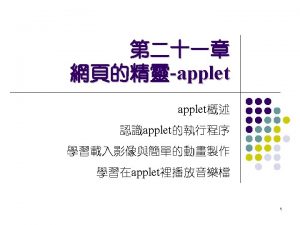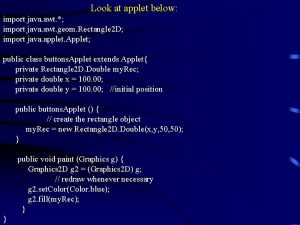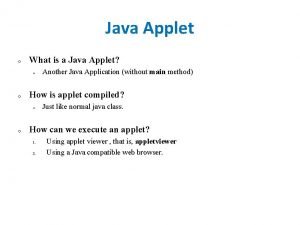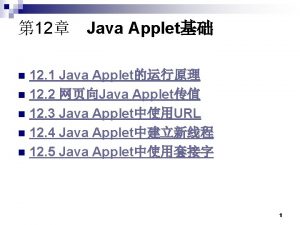2 1 2 1 import java applet Applet


![[예제 2. 1] 간단한 애플릿 프로그램 import java. applet. Applet; import java. awt. *; [예제 2. 1] 간단한 애플릿 프로그램 import java. applet. Applet; import java. awt. *;](https://slidetodoc.com/presentation_image_h/e492ba43f0625c5d557ad6f260551eb6/image-3.jpg)




![[예제 2. 2] 애플릿 실행과정을 보이는 예 /* <applet code="Exec. Seq" width="200" height="100"> </applet> [예제 2. 2] 애플릿 실행과정을 보이는 예 /* <applet code="Exec. Seq" width="200" height="100"> </applet>](https://slidetodoc.com/presentation_image_h/e492ba43f0625c5d557ad6f260551eb6/image-8.jpg)



![[예제 2. 3] HTML에서 애플릿으로 매개변수 전달 예 import java. applet. *; import java. [예제 2. 3] HTML에서 애플릿으로 매개변수 전달 예 import java. applet. *; import java.](https://slidetodoc.com/presentation_image_h/e492ba43f0625c5d557ad6f260551eb6/image-12.jpg)


![[예제 2. 4] 선 그리기 import java. applet. *; import java. awt. Graphics; /* [예제 2. 4] 선 그리기 import java. applet. *; import java. awt. Graphics; /*](https://slidetodoc.com/presentation_image_h/e492ba43f0625c5d557ad6f260551eb6/image-15.jpg)

![[예제 2. 5] 사각형 그리기 import java. applet. *; import java. awt. Graphics; /* [예제 2. 5] 사각형 그리기 import java. applet. *; import java. awt. Graphics; /*](https://slidetodoc.com/presentation_image_h/e492ba43f0625c5d557ad6f260551eb6/image-17.jpg)

![[예제 2. 6] 원과 타원 그리기 import java. applet. *; import java. awt. Graphics; [예제 2. 6] 원과 타원 그리기 import java. applet. *; import java. awt. Graphics;](https://slidetodoc.com/presentation_image_h/e492ba43f0625c5d557ad6f260551eb6/image-19.jpg)

![[예제 2. 7] 호 그리기 import java. applet. *; import java. awt. Graphics; /* [예제 2. 7] 호 그리기 import java. applet. *; import java. awt. Graphics; /*](https://slidetodoc.com/presentation_image_h/e492ba43f0625c5d557ad6f260551eb6/image-21.jpg)
![2. 5 AWT를 이용한 간단한 프로그래밍(계속) • 다각형 그리기 – void draw. Polygon(int[] x, 2. 5 AWT를 이용한 간단한 프로그래밍(계속) • 다각형 그리기 – void draw. Polygon(int[] x,](https://slidetodoc.com/presentation_image_h/e492ba43f0625c5d557ad6f260551eb6/image-22.jpg)
![[예제 2. 8] 다각형 그리기 import java. applet. *; import java. awt. Graphics; /* [예제 2. 8] 다각형 그리기 import java. applet. *; import java. awt. Graphics; /*](https://slidetodoc.com/presentation_image_h/e492ba43f0625c5d557ad6f260551eb6/image-23.jpg)

![[예제 2. 9] 색 지정의 예 import java. applet. *; import java. awt. Graphics; [예제 2. 9] 색 지정의 예 import java. applet. *; import java. awt. Graphics;](https://slidetodoc.com/presentation_image_h/e492ba43f0625c5d557ad6f260551eb6/image-25.jpg)


![[예제 2. 10] 글꼴 지정의 예 import java. applet. *; import java. awt. Graphics; [예제 2. 10] 글꼴 지정의 예 import java. applet. *; import java. awt. Graphics;](https://slidetodoc.com/presentation_image_h/e492ba43f0625c5d557ad6f260551eb6/image-28.jpg)

- Slides: 29


2. 1 애플릿 기초 • 애플릿 – 웹 브라우저에서 실행되는 자바 프로그램 • 애플릿 기초 – [예제 2. 1] • • import java. applet. Applet; import java. awt. *; main 메소드가 없다. void draw. String(String str, int i, int j) <applet code=“Hello” width=200 height=100> </applet>
![예제 2 1 간단한 애플릿 프로그램 import java applet Applet import java awt [예제 2. 1] 간단한 애플릿 프로그램 import java. applet. Applet; import java. awt. *;](https://slidetodoc.com/presentation_image_h/e492ba43f0625c5d557ad6f260551eb6/image-3.jpg)
[예제 2. 1] 간단한 애플릿 프로그램 import java. applet. Applet; import java. awt. *; public class Hello extends Applet { public void paint(Graphics g) { g. draw. String("Hello java", 50, 30); } } [실행결과]

2. 2 애플릿의 기본 구조 • • • init() start() stop() destory() paint(Graphics g) repaint() init start paint stop destroy 애플릿의 실행 과정



![예제 2 2 애플릿 실행과정을 보이는 예 applet codeExec Seq width200 height100 applet [예제 2. 2] 애플릿 실행과정을 보이는 예 /* <applet code="Exec. Seq" width="200" height="100"> </applet>](https://slidetodoc.com/presentation_image_h/e492ba43f0625c5d557ad6f260551eb6/image-8.jpg)
[예제 2. 2] 애플릿 실행과정을 보이는 예 /* <applet code="Exec. Seq" width="200" height="100"> </applet> */ import java. applet. *; import java. awt. *; public class Exec. Seq extends Applet { int init=0, start=0, stop=0; String msg 1, msg 2, msg 3; public void init() { init++; } public void start() { start++; } public void stop() { stop++; } public void paint(Graphics g) { msg 1="The number of init() call: " + init; msg 2="The number of start() call: " + start; msg 3="The number of stop() call: " + stop; g. draw. String(msg 1, 20, 40); g. draw. String(msg 2, 20, 60); g. draw. String(msg 3, 20, 80); } }



2. 4 HTML 파일에서 애플릿으 로 매개변수 전달 • String get. Parameter(String parm. Name) • 예: – HTML파일 • <param name=“SIZE” value=“ 55”> – 대응되는 애플릿 코드 • String font. Size = get. Parameter(“SIZE”); • [예제 2. 3]
![예제 2 3 HTML에서 애플릿으로 매개변수 전달 예 import java applet import java [예제 2. 3] HTML에서 애플릿으로 매개변수 전달 예 import java. applet. *; import java.](https://slidetodoc.com/presentation_image_h/e492ba43f0625c5d557ad6f260551eb6/image-12.jpg)
[예제 2. 3] HTML에서 애플릿으로 매개변수 전달 예 import java. applet. *; import java. awt. Graphics; /* <applet code="Param" width="300" height="80"> <param name="degree" value="20"> <param name="Message" value="안녕"> </applet> */ public class Param extends Applet { String m 1, m 2; int size; public void start() { m 1 = get. Parameter("Message"); if (m 1 == null) m 1 = "No good"; m 2 = get. Parameter("degree"); if (m 2 == null) size = 5; else size = Integer. parse. Int(m 2); } public void paint(Graphics g) { g. draw. String("Message received: " + m 1, 0, 15); g. draw. String("Degree: " + size, 0, 40); } }


2. 5 AWT를 이용한 간단한 프로그래밍 • 스트링 그리기 – void draw. String(string msg, int x, int y) • 선 그리기 – void draw. Line(int x 1, int y 1, int x 2, int y 2) • [예제 2. 4]
![예제 2 4 선 그리기 import java applet import java awt Graphics [예제 2. 4] 선 그리기 import java. applet. *; import java. awt. Graphics; /*](https://slidetodoc.com/presentation_image_h/e492ba43f0625c5d557ad6f260551eb6/image-15.jpg)
[예제 2. 4] 선 그리기 import java. applet. *; import java. awt. Graphics; /* <applet code="Line. Test" width="200" height="100"> </applet> */ public class Line. Test extends Applet { public void paint(Graphics g) { g. draw. Line(20, 40, 160, 80); g. draw. Line(180, 20, 50, 90); } } [실행결과]

2. 5 AWT를 이용한 간단한 프로그래밍(계속) • 사각형 그리기 – void draw. Rect(int x, int y, int width, int height) – void fill. Rect(int x, int y, int width, int height) – void draw. Round. Rect(int x, int y, int width, int height, int rw, int rh) – void fill. Round. Rect(int x, int y, int width, int height, int rw, int rh) • [예제 2. 5]
![예제 2 5 사각형 그리기 import java applet import java awt Graphics [예제 2. 5] 사각형 그리기 import java. applet. *; import java. awt. Graphics; /*](https://slidetodoc.com/presentation_image_h/e492ba43f0625c5d557ad6f260551eb6/image-17.jpg)
[예제 2. 5] 사각형 그리기 import java. applet. *; import java. awt. Graphics; /* <applet code="Rectangle. Test" width="200" height="150"> </applet> */ public class Rectangle. Test extends Applet { public void paint(Graphics g) { g. draw. Rect(40, 20, 50); g. fill. Rect(100, 20, 50); g. draw. Round. Rect(40, 90, 50, 20); g. fill. Round. Rect(100, 90, 50, 20); } } [실행결과]

2. 5 AWT를 이용한 간단한 프로그래밍(계속) • 원, 타원 그리기 – void draw. Oval(int x, int y, int width, int height) – void fill. Oval(int x, int y, int width, int height) • [예제 2. 6]
![예제 2 6 원과 타원 그리기 import java applet import java awt Graphics [예제 2. 6] 원과 타원 그리기 import java. applet. *; import java. awt. Graphics;](https://slidetodoc.com/presentation_image_h/e492ba43f0625c5d557ad6f260551eb6/image-19.jpg)
[예제 2. 6] 원과 타원 그리기 import java. applet. *; import java. awt. Graphics; /* <applet code="Oval. Test" width="200" height="100"> </applet> */ public class Oval. Test extends Applet { public void paint(Graphics g) { g. draw. Oval(40, 20, 50); g. fill. Oval(100, 20, 50, 80); } } [실행결과]

2. 5 AWT를 이용한 간단한 프로그래밍(계속) • 호 그리기 – void draw. Arc(int x, int y, int width, int height, int a. Degree, int b. Degree) – void fill. Arc(int x, int y, int width, int height, int a. Degree, int b. Degree) • [예제 2. 7]
![예제 2 7 호 그리기 import java applet import java awt Graphics [예제 2. 7] 호 그리기 import java. applet. *; import java. awt. Graphics; /*](https://slidetodoc.com/presentation_image_h/e492ba43f0625c5d557ad6f260551eb6/image-21.jpg)
[예제 2. 7] 호 그리기 import java. applet. *; import java. awt. Graphics; /* <applet code="Arc. Test" width="200" height="100"> </applet> */ public class Arc. Test extends Applet { public void paint(Graphics g) { g. draw. Arc(40, 20, 50, 90, 180); g. fill. Arc(100, 20, 50, 80, 45, 240); } } [실행결과]
![2 5 AWT를 이용한 간단한 프로그래밍계속 다각형 그리기 void draw Polygonint x 2. 5 AWT를 이용한 간단한 프로그래밍(계속) • 다각형 그리기 – void draw. Polygon(int[] x,](https://slidetodoc.com/presentation_image_h/e492ba43f0625c5d557ad6f260551eb6/image-22.jpg)
2. 5 AWT를 이용한 간단한 프로그래밍(계속) • 다각형 그리기 – void draw. Polygon(int[] x, int[] y, int n. Points) – void fill. Polygon(Int[] x, int[] y, int n. Points) • [예제 2. 8]
![예제 2 8 다각형 그리기 import java applet import java awt Graphics [예제 2. 8] 다각형 그리기 import java. applet. *; import java. awt. Graphics; /*](https://slidetodoc.com/presentation_image_h/e492ba43f0625c5d557ad6f260551eb6/image-23.jpg)
[예제 2. 8] 다각형 그리기 import java. applet. *; import java. awt. Graphics; /* <applet code="Polygon. Test" width="200" height="150"> </applet> */ public class Polygon. Test extends Applet { public void paint(Graphics g) { int[] x 1={50, 25, 60, 90, 55}; int[] y 1={50, 70, 95, 40, 30}; int n 1=x 1. length; int[] x 2={130, 105, 140, 170, 135}; int[] y 2={50, 70, 95, 40, 30}; int n 2=x 2. length; g. draw. Polygon(x 1, y 1, n 1); g. fill. Polygon(x 2, y 2, n 2); } } [실행결과]

2. 5 AWT를 이용한 간단한 프로그래밍(색) • • void set. Color(Color new. Color) void set. Background(Color new. Color) void set. Foreground(Color new. Color) 클래스 Color의 생성자를 이용한 색 지정 – Color(int r, int g, int b) // 0에서 255 사이의 값 – Color(float r, float g, float b) // 0. 0에서 1. 0 사이의 값 • 자바에서 자주 사용하는 Color 상수 – Color. black, Color. blue, Color. cyan, Color. dark. Gray, Color. gray, Color. green, Color. light. Gray, Color. magenta, Color. orange, Color. white, Color. red, Color. pink, Color. yellow • [예제 2. 9]
![예제 2 9 색 지정의 예 import java applet import java awt Graphics [예제 2. 9] 색 지정의 예 import java. applet. *; import java. awt. Graphics;](https://slidetodoc.com/presentation_image_h/e492ba43f0625c5d557ad6f260551eb6/image-25.jpg)
[예제 2. 9] 색 지정의 예 import java. applet. *; import java. awt. Graphics; import java. awt. Color; /* <applet code="Color. Test" width="200" height="150"> </applet> */ public class Color. Test extends Applet { public void paint(Graphics g) { int i; for (i=1; i<6; i++) { switch (i) { case 1 : g. set. Color(Color. red); break; case 2 : g. set. Color(Color. pink); break; case 3 : g. set. Color(Color. orange); break; case 4 : g. set. Color(Color. magenta); break; case 5 : g. set. Color(new Color(0, 0, 255)); break; } g. draw. String("Hello Java", 30, i*20); } } } [실행결과]


2. 5 AWT를 이용한 간단한 프로그래밍(글꼴) • 자바에서 지원하는 기본 글꼴 – Courier, Dialog. Input Helvetica, Times. Roman, Zapf. Dingbats • 스타일 – Font. PLAIN, Font. ITALIC, Font. BOLD, Font. BOLD+Font. ITALIC • 클래스 Font의 생성자 – Font(Sring font. Name, int font. Style, int size) • void set. Font(Font font. Object) • [예제 2. 10]
![예제 2 10 글꼴 지정의 예 import java applet import java awt Graphics [예제 2. 10] 글꼴 지정의 예 import java. applet. *; import java. awt. Graphics;](https://slidetodoc.com/presentation_image_h/e492ba43f0625c5d557ad6f260551eb6/image-28.jpg)
[예제 2. 10] 글꼴 지정의 예 import java. applet. *; import java. awt. Graphics; import java. awt. Color; import java. awt. Font; /* <applet code="Font. Test" width="420" height="100"> </applet> */ public class Font. Test extends Applet { public void paint(Graphics g) { Font fp = new Font("Times. Roman", Font. PLAIN, 17); Font fb = new Font("Helventica", Font. BOLD, 17); Font fi = new Font("Courier", Font. ITALIC, 17); Font fbi = new Font("Dialog", Font. BOLD+Font. ITALIC, 17); g. set. Font(fp); g. set. Color(Color. black); g. draw. String("Font: Times. Roman, Styles: Plain, Color: Black", 10, 22); g. set. Font(fb); g. set. Color(Color. red); g. draw. String("Font: Helventica, Styles: Bold, Color: Red", 10, 44); g. set. Font(fi); g. set. Color(Color. blue); g. draw. String("Font: Courier, Styles: Italic, Color: Blue", 10, 66); g. set. Font(fbi); g. set. Color(Color. green); g. draw. String("Font: Dialog, Styles: Bold+Italic, Color: Green", 10, 88); } }

 Import java.applet.applet
Import java.applet.applet Import java.applet.applet
Import java.applet.applet Applet class
Applet class Applet example
Applet example Import java.applet.applet
Import java.applet.applet 자바 매개변수
자바 매개변수 Import java.applet.applet
Import java.applet.applet Import java.awt.event.*
Import java.awt.event.* Import java.util.*;
Import java.util.*; Import java.applet.*
Import java.applet.* Difference between local and remote applet
Difference between local and remote applet Import java.util.scanner;
Import java.util.scanner; Java import java.io.*
Java import java.io.* Import java.util.*
Import java.util.* Java import java.util.*
Java import java.util.* Import java scanner
Import java scanner Java thread import
Java thread import Java.util.random
Java.util.random Gcd java
Gcd java Import numpy as np import matplotlib.pyplot as plt
Import numpy as np import matplotlib.pyplot as plt Applet java ejemplo
Applet java ejemplo Java applet games
Java applet games Java applet test
Java applet test Hierarchy of applet
Hierarchy of applet Applet program in java
Applet program in java Java applet program draw cartoon
Java applet program draw cartoon Applet structure in java
Applet structure in java Java applet hello world
Java applet hello world Syntax of applet tag in java
Syntax of applet tag in java Moving ball program in java using applet
Moving ball program in java using applet



